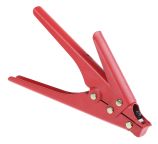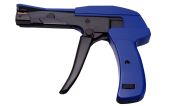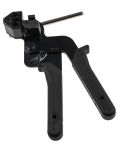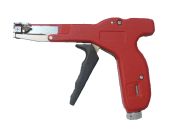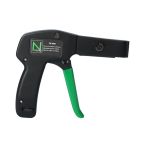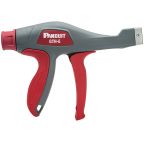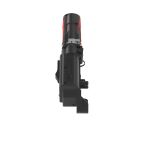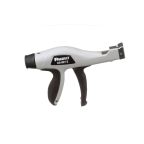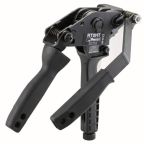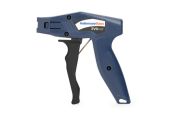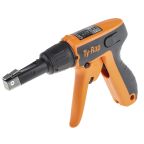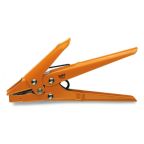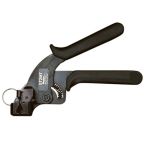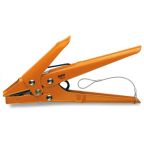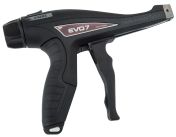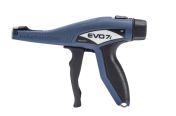- Automation & Control Gear
- Cables & Wires
- Enclosures & Server Racks
- Fuses & Circuit Breakers
- HVAC, Fans & Thermal Management
- Lighting
- Relays & Signal Conditioning
- Switches
- Batteries & Chargers
- Connectors
- Displays & Optoelectronics
- ESD Control, Cleanroom & PCB Prototyping
- Passive Components
- Power Supplies & Transformers
- Raspberry Pi, Arduino, ROCK, STEM Education & Development Tools
- Semiconductors
Cable Tie Guns
Cable tie guns are indispensable tools for efficient, consistent, and professional cable management. These devices simplify the process of fastening and tensioning cable ties, ensuring secure bundles and a tidy installation in various industries and applications. By providing precise tension control and clean cutting of excess tie material, cable tie guns improve both the safety and aesthetics of cable installations.
How Does a Cable Tie Gun Work?
Similar to pliers, a cable tie gun operates on a straightforward mechanical principle, allowing for precise tensioning and cutting of cable ties. First, the operator loads a zip tie into the gun's mechanism. As the handles are squeezed, an internal ratchet system pulls the cable tie, progressively tightening it around the bundle of wires or cables.
Once a predetermined tension is reached, a cutting blade automatically severs the excess tail of the cable tie, resulting in a neat and secure fastening. This automated process ensures consistent tension across multiple ties, which is critical for preventing overtightening that could damage cables or undertightening that could lead to loose bundles.
What Are Cable Tie Tensioning Tools Used For?
Cable tie tensioning tools are essential for achieving precise and consistent fastening in cable management applications. They are used to apply the correct amount of tension to a cable tie, which is crucial for both securing cable bundles and preserving the integrity of the cables themselves.
These tools help ensure compliance with industry codes and standards that often dictate appropriate tension levels to prevent damage to insulation or signal interference. Designed for efficiency, they allow users to perform numerous fastenings with minimal effort, maintaining functionality even with long-term use. Most versions are also fitted with an integrated cutting blade, which automatically trims off the excess cable tie material after tensioning, contributing to a cleaner and safer installation.
Types of Cable Tie Tensioning Tools?
Cable tie guns are designed to work with the different materials, such as nylon and stainless steel, used to make cable ties. Some of the common ones include:
- Manual Cable Tie Guns: These are handheld tools operated by squeezing a trigger or handle. They are suitable for light to medium-duty applications and offer a cost-effective solution for general cable management.
- Pneumatic Cable Tie Guns: Powered by compressed air, pneumatic cable tie guns provide faster and more consistent tensioning, making them ideal for high-volume production environments. They reduce operator fatigue and ensure uniform tension across numerous cable ties.
- Battery-Powered Cable Tie Guns: These cordless tools offer portability and convenience, combining the power of automated tensioning with the flexibility of a handheld device. They are suitable for various applications where access to power outlets is limited.
- Stainless Steel Cable Tie Tools: Specifically designed for stainless steel cable ties, these heavy-duty tools feature robust construction and specialised mechanisms to apply and cut metal ties, which require significantly more force than nylon ties.
Key Features to Look For in a Cable Tie Gun
Selecting the right cable tie gun involves considering features that enhance precision, efficiency, and user comfort. A well-chosen tool can significantly improve the quality and speed of your cable management tasks.
- Adjustable Tension Settings: This feature allows the user to precisely control the fastening force applied to the cable tie. It is crucial for preventing overtightening, which can damage cables, and ensuring consistent tension across multiple ties for a neat and secure bundle.
- Automatic Cut-Off: An automatic cut-off mechanism cleanly trims the excess tail of the cable tie once the predetermined tension is reached. This creates a flush finish, eliminating sharp edges that could cause injury or snag on other components, and ensures a professional appearance.
- Ergonomic Grip: A well-designed ergonomic grip minimises hand fatigue during prolonged use, making the tool more comfortable and safer to operate. This feature is particularly important in high-volume applications or when working in tight spaces.
- Durability: The tool's construction material and design should ensure it can withstand frequent use and demanding work environments. Durable cable tie guns are typically made from robust metals or high-impact plastics, ensuring a long service life.
- Compatibility with Different Tie Sizes: Many cable tie guns are designed to accommodate a range of cable tie widths and thicknesses. Checking for compatibility ensures the tool can be used with the specific ties required for your various projects, offering greater versatility.
How to Use a Cable Tie Gun Safely and Effectively
Using a cable tie gun correctly not only ensures a secure fastening but also promotes safety and extends the life of your tool. Follow these basic steps for effective and safe operation:
- Insert the zip tie into the tool's mechanism, ensuring the tail is aligned correctly for tensioning.
- Position the head of the cable tie gun firmly against the cable bundle.
- Gradually pull the trigger or squeeze the handles to initiate the tightening process. As you apply pressure, the tool will tension the tie. Once the pre-set tension is reached, the automatic cut-off mechanism will activate, cleanly trimming the excess tail.
Always remember not to overtighten the ties, as this can damage the cables or the tie itself. For prolonged use or in dusty environments, wearing appropriate safety gear, such as eye protection and work gloves, is advisable.
Industries That Use Cable Tie Guns
Cable tie guns are invaluable tools across a diverse range of industries, where efficient, secure, and precise cable management is essential for operational integrity and safety.
- Automotive: Used extensively in vehicle assembly and repair for securing wiring harnesses, hoses, and cables within the confined spaces of engines and chassis, ensuring components are stable and protected from vibration.
- Aerospace: Critical for fastening intricate wiring looms in aircraft, where consistent tension and a clean finish are vital for safety, weight management, and performance in demanding airborne conditions.
- Telecommunications: Employed for organising and securing communication cables in server rooms, data centres, and outdoor installations, ensuring network reliability and ease of maintenance.
- Construction: Indispensable for electrical installations in commercial and residential buildings, ensuring wires are neatly bundled and securely routed, contributing to safety and compliance with building codes.
- Manufacturing: Used on production lines for efficiently bundling and securing cables in electronic devices, appliances, and machinery, improving assembly speed and product quality.
- Marine: Ideal for securing electrical wiring and components in boats and ships, where resistance to corrosion and vibration is crucial for reliability in harsh maritime environments.
- Rail and Transportation: Essential for managing complex cabling systems in trains, trams, and public transport infrastructure, ensuring safety and functionality of signalling, power, and communication systems.
- Data Centres and IT: Utilised for maintaining highly organised and well-ventilated cable infrastructure within data racks and server cabinets, preventing airflow obstruction and simplifying troubleshooting in critical IT environments.
Trusted Cable Tie Guns Manufacturer, Supplier & Distributor in Malaysia
When it comes to high-quality cable tie guns that deliver precision and reliability, RS is a trusted and leading supplier and distributor in Malaysia. We offer an extensive selection of cable tie guns from reputable brands including HellermannTyton, Panduit and RND. Our range ensures you can find the perfect tool for any cable management task, from light-duty applications to heavy-duty stainless steel tie fastening.
Enjoy a seamless shopping experience with competitive pricing and efficient delivery services. For more information on delivery options and policies, please refer to our dedicated Delivery Page.

